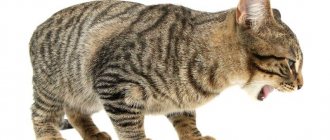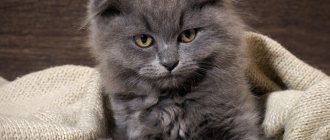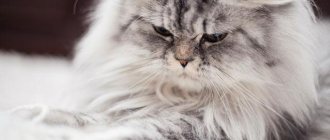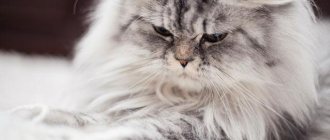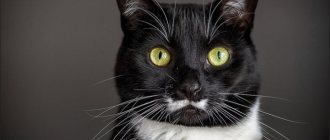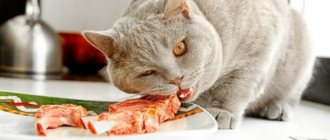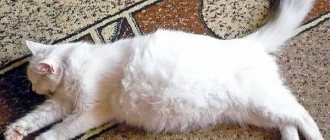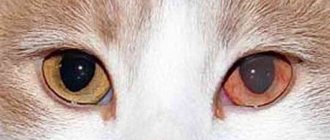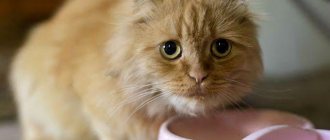Vomiting in cats is not always a sign of illness. Many animals specifically cause it when they feel heaviness in their body. However, if you can identify blood, bile or mucus in the vomit, then you should be wary.
But the owner will not always be able to distinguish whether the cat has a disease or whether it was a physiological need.
If vomiting is accompanied by additional symptoms - diarrhea, fever, then you should definitely show the animal to a veterinarian.
Vomiting is observed in cats with most infectious diseases, poisoning, and diseases of the gastrointestinal tract. Some of the most serious causes of vomiting in cats are intestinal obstruction and volvulus. In this case, only emergency assistance from a veterinarian can save your pet’s life.
Causes of vomiting in cats:
The reasons may vary, but they are all indicators that your pet has health problems and will need help.
Sometimes, of course, cats themselves provoke vomiting in order to free the esophagus or stomach from a foreign object that has entered it, for example, trichobezoar is a common phenomenon (an accumulation of hair in the animal’s stomach and the formation of a coma from it).
If the cat is not bothered by the trichobezoar, then vomiting can be caused by:
- viral infections;
- diseases of the gastrointestinal tract;
- banal poisoning;
- the presence of worms and other parasites;
- tumors;
- bacterial diseases.
In general, vomiting is a common accompanying symptom of almost all diseases. Even under normal stress, a cat can vomit.
Usually, vomiting is accompanied by a couple of other signs of a particular disease, for example, lethargy, apathy, diarrhea, poor appetite, and increased body temperature. The only thing that should be well remembered when vomiting occurs is that you should never try to cure the animal yourself; in such situations only a doctor can help.
Self-diagnosis
The appearance of vomiting and the behavior of the kitten cannot make a final diagnosis, but the owner can assess the general condition of the animal and make a preliminary decision on its treatment. If something changes later, the decision may need to be revised.
© shutterstock
Encouraging signs
You don’t have to worry too much and limit yourself to home treatment if the following easily noticeable signs are observed:.
- The kitten vomited undigested or poorly digested food once - this happens from overeating.
- The kitten behaves actively, does not refuse water and food, and no additional symptoms are observed.
- It was possible to see fur in the vomit.
- The kitten recently arrived in the house and vomiting is not accompanied by a refusal of water, convulsions, or an increase in temperature - most likely, the unusual diet is to blame. It’s worth analyzing it and asking the cat’s owner what kind of food the kitten previously needed.
It is almost certain that if such symptoms are present, the vomiting will stop quickly and there will be no consequences. If the symptoms persist, the help of a veterinarian will still be required.
Threatening symptoms
But there are signs when it is better to immediately seek advice from a specialist..
- A kitten vomits blood - a sign of mechanical damage to the esophagus or stomach or severe internal pathologies.
- Vomiting occurs repeatedly, and bile is present in the mass (it is yellow) - serious disturbances in the functioning of the liver and bile ducts are possible.
- There is white foam in the vomit - this may indicate infection.
- Worms were found in the mass - they should be removed immediately.
- Vomiting is accompanied by diarrhea - a sign of poisoning.
- A kitten refuses to eat and does not drink - a threat to life, whatever the reason.
- Vomiting is accompanied by convulsions, apathy, and fever.
Yes, kittens can vomit (just like children) for minor reasons, “in the mood.” But, if the owner notices at least some threatening signs, he should immediately begin to treat the animal, because otherwise it may be too late.
Cat vomits after eating
When a cat is provoked to vomit after eating, this may indicate problems with the stomach, intestines, and also a very dangerous disease - intestinal obstruction. If the cat vomits once, there is no need to worry; it may be a single reaction of the body to any irritant.
If a cat experiences vomiting more than once, then you should seek professional help from our clinic, since the sooner a cat’s disease is diagnosed, the greater the chance of curing it and saving its life (for example, in the case of intestinal obstruction, days and hours count ).
What to do after wisdom tooth removal
The third molar is usually pulled out due to inflammation that appears around it. At the same time, pus and infectious agents are likely to get into the wound. Therefore, in the postoperative period, the patient must follow general recommendations, as well as be as attentive as possible to his feelings, and note the slightest changes in his condition.
As soon as the hole stops bleeding, you should immediately remove the compression tampon. Its presence in the wound provokes the proliferation of bacteria and increases the likelihood of the onset of an inflammatory process.
The patient should be prepared for the fact that his gums will hurt for 3-5 days after the procedure. You need to purchase recommended anesthetics and take them on schedule. If the pain syndrome has become stronger, swelling of the face and gums increases over the course of several days, the elevated temperature does not subside, and an unpleasant odor begins to come from the socket, you need to call the dentist.
Treatment of vomiting in a cat
Our specialists begin treatment of vomiting in a cat by collecting anamnesis and additional research. Depending on the existing picture, the doctor prescribes blood and urine tests. If you suspect a particular disease, an X-ray examination, ultrasound, special tests, samples, and so on will be necessary.
Before your cat is taken to the hospital, you will need to relieve her condition. To do this, stop feeding and watering the animal.
Never try to induce vomiting in a cat yourself unless you are sure that it has not eaten any chemicals or liquids, because then the animal will only get worse, because poisons leaving the stomach through the esophagus have a destructive effect on the organs. Therefore, the only thing you can do is to make sure that the cat does not eat anything else until it is examined by a doctor.
What to do after tooth extraction
After the dentist has completed all removal procedures, the patient must take the following measures:
- The tampon that the doctor placed on the hole must be removed no later than half an hour later. If the patient has poor blood clotting, you can keep the compression pad on for 60 minutes;
- To reduce the likelihood of swelling of the soft tissues of the mouth or face, it is advisable to apply something cold to the cheek. This treatment measure will be effective only in the first hours after surgery. A piece of ice or frozen meat wrapped in cloth should be applied to the cheek several times for 5 minutes;
- On the first day, to avoid inflammation, you can do antiseptic baths;
- It is necessary to gently, carefully, but carefully carry out all hygiene procedures in the oral cavity, not excluding the area where the tooth was pulled out.
Compliance with these rules after removal will promote rapid healing of the hole and prevent infection.
Diarrhea and vomiting in cats
A single vomiting in a cat with fur is quite common, but diarrhea and vomiting in cats is already a reason to contact a veterinarian .
- Try to remember when the cat first vomited, how often it occurs, what its consistency is, and whether there are any other symptoms.
- Pay special attention to the color of the vomit: yellow and especially green, it signals that the cat has serious problems with the gastrointestinal tract.
Also, vomiting with mucus indicates chronic gastritis and even worms. Especially if mucus is also present in the stool.
What to do after removing a tooth with a cyst
After the doctor removes a tooth with a cyst, you need to follow the general recommendations of the recovery period, but pay special attention to reducing the likelihood of infection of the wound.
In the initial period after the procedure, it is necessary to cool the sore side of the jaw by applying 3-4 cold compresses. Next, you need to ensure that the operated part of the face does not overheat. It is forbidden to make warming compresses, take hot baths, or sunbathe. For pain relief, you can take medications prescribed by your doctor.
It is necessary to avoid injuring the healing hole - the food is soft or liquid, not hot; brush your teeth as carefully as possible; Do not rinse your mouth. It is necessary to limit physical activity and monitor local and general temperature. If pain, high body temperature and swelling lasts more than 2 days, consult a doctor. If pus begins to discharge or there is an unpleasant odor coming from the hole, consult a doctor immediately.
What to do when a cat vomits
What to do if your cat is vomiting depends on the nature of its manifestation. If a cat is tearing its hair, then it is worth monitoring it more carefully and combing it more often. If you are vomiting with bile and mucus, then you should contact a veterinarian who will check the condition of the gastrointestinal tract for the absence of pathologies.
A single vomiting of white foam is usually not dangerous, since it is caused by a lack of food in the stomach.
If your pet vomits blood, you should immediately contact your veterinarian. This may be a sign that the animal has swallowed a foreign body and it is scratching the walls of the esophagus.
As soon as you notice that your cat is vomiting, do not feed it. If the symptoms do not go away, then it is better to show the animal to a veterinarian, since it is impossible for a non-specialist to independently determine what the cause is.
Prices for appointments in our clinics
| Name of veterinary services | Unit | Price, rub |
| ⭐ Initial appointment | 1 animal | 400 |
| ⭐ Repeated appointment | 1 animal | 250 |
| Initial appointment with a specialist | 1 animal | 1100 |
| Consultation without an animal | — | 550 |
| Consultation with a doctor based on test results | 1 PC. | 400 |
| Weighing animals | 1 animal | For free |
| Additional fixation for aggressive animal behavior | 1 animal | 700 |
CLINIC REGISTRATION
HOME CALL
All our Veterinary Clinics:
For any suggestions regarding the site: [email protected]
|
